Baklava! It’s so fun to say and it’s a perfect dessert, but sometimes can be time consuming to make. Instead, try my solution for a simpler version — baklava rolls!
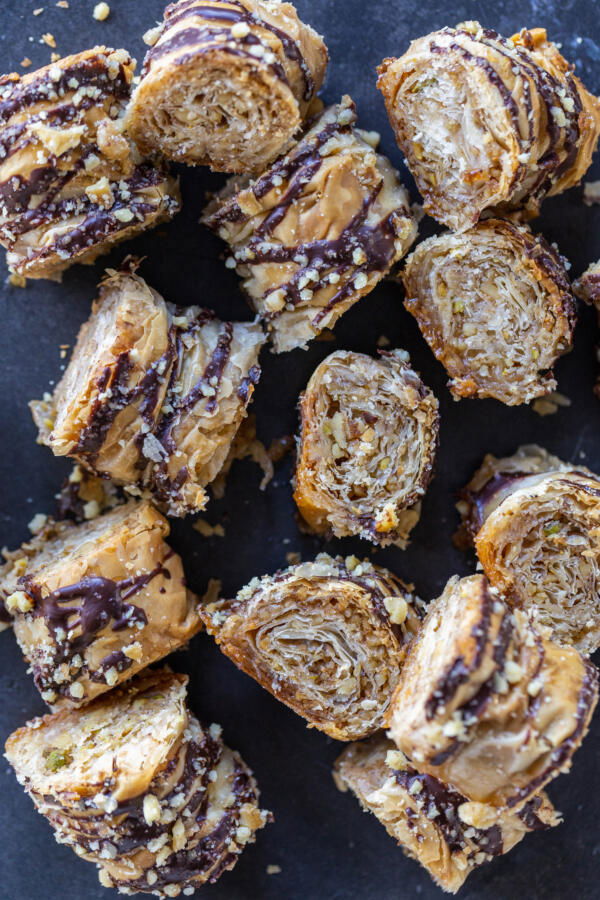
Baklava has an unfortunate rap for being a bit difficult to make (at least for the beginner baker), but this version takes out all the hard work. I truly believe this is the easiest rolled baklava recipe you will come across (and a lot of my readers over the years think so too!). A little bit of work and your baklava will be flaky, chewy, nutty, and so yummy. But don’t tell me I didn’t warn you — you might have trouble observing a diet with this one.
The first time I made baklava according to this recipe, I was hoping to “show off” and share it with a bunch of friends, but it was devoured too quickly and too soon by my own family (and myself, if I’m honest). I ended up quickly making it again, this time making sure to practice self restraint so I had enough to share. I don’t consider myself a frequent baker, but making this dessert combined all my favorite things about baking — a helpful shortcut, a small ingredient list, and no skimping on the sugar.
How To Make Baklava Rolls
In this easy baklava recipe, I use a rolling method to skip some of the manual labor of making traditional baklava. When I created this version, I didn’t realize how dangerous it was going to be to have such a simple baklava recipe. Let’s run through the process real quick before you start.
- Chop the nuts: Use a food processor to quickly chop the nuts into tiny pieces.
- Make the filling: In a medium bowl, toss the chopped nuts with powdered sugar and cinnamon. In a small bowl, melt the butter.
- Prepare the sheets of phyllo dough: On a large cutting board, lay out the phyllo one sheet at a time, brushing each with melted butter. Layer three of the sheets on top of each other.
- Assemble the rolled baklava: Sprinkle 1/3 cup of the nut mixture onto the three-layer buttered sheets. Then, roll it up into a tight roll. Transfer the baklava log to a 9×13 baking pan and repeat the rolling process until you run out of ingredients.
- Brush & bake the rolled baklava: Brush the rolled baklava with remaining melted butter, then bake at 375°F for 25 minutes.
- Soak the rolled baklava: In a saucepan, combine the sugar and water and simmer it on low for 10 minutes. Optionally, add in a few cinnamon sticks while the syrup comes together. Add the honey and stir to combine. Pour the sweet mixture over the baklava in the baking tray and let it soak at room temperature for three hours.
- Slice the baklava: Slice the baklava into bite-sized pieces and decorate each piece with melted chocolate, chopped nuts or even a clove, if you wish.
Hot tip: To deepen the flavor profile, add a couple of tablespoons of fresh lemon juice, rose water, or orange blossom water to the sweet mixture.

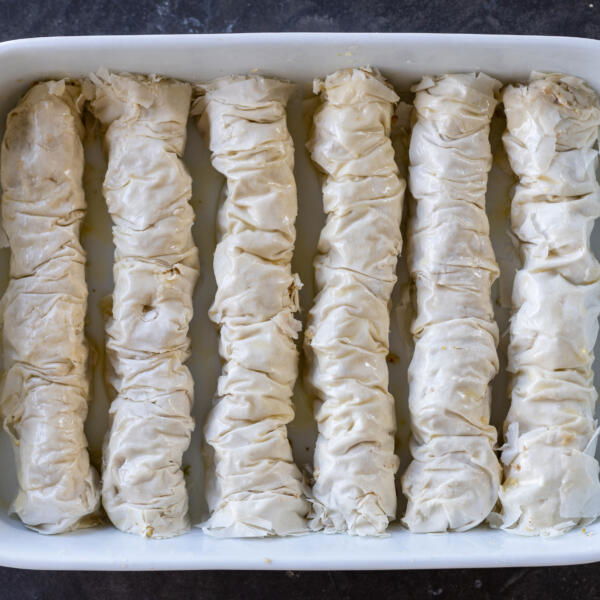
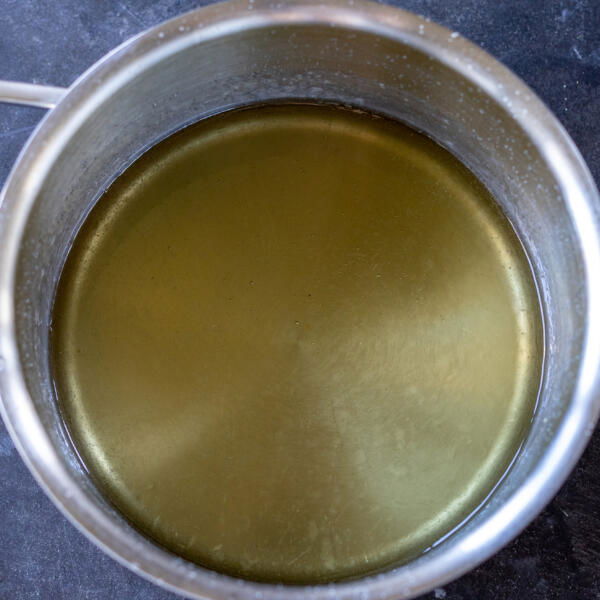
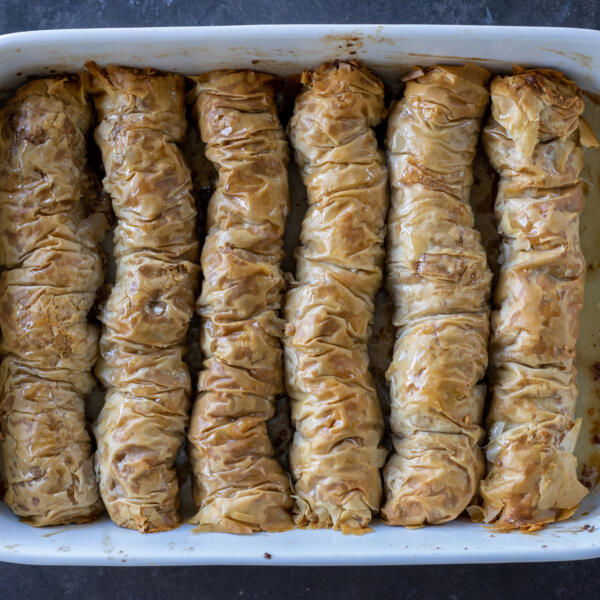
Tips for Making Baklava Rolls
If you’re used to making traditional baklava, this rolled variation has some slight differences. And if you’re totally new to baklava, that’s okay, too! Check out these tips to help you nail the process no matter your experience level!
- Use a food processor to chop the nuts: Use a food processor to chop your nuts and save yourself a battle with a knife. Pulse the nuts about ten times to get them to the correct coarseness.
- Change up the nuts (optional): There are so many different types of baklava out there. Some chefs use ground pistachios instead of walnuts, while others use almonds. Use whatever nut you like best!
- Be swift with the phyllo: Work with your phyllo dough as quickly as possible to prevent it from drying out. The longer it sits at room temperature, the more prone it is to be too difficult to work with and roll. Then, it won’t crisp up as it should when baking.
- Roll as tightly as possible: Roll your rolls as tight as possible. This ensures you have even and smooth layers on the inside.
- Soak the baklava while it’s still hot: Pour the honey and sugar mixture on the baklava rolls while they are still hot. This helps them soak up the mixture much better and is what creates the tender texture you’re looking for (otherwise the baklava will come out hard!).
- Allow the baklava to rest at room temperature: Let the baklava rest at room temperature for at least three hours uncovered before eating for the best results. If you can, overnight works even better!
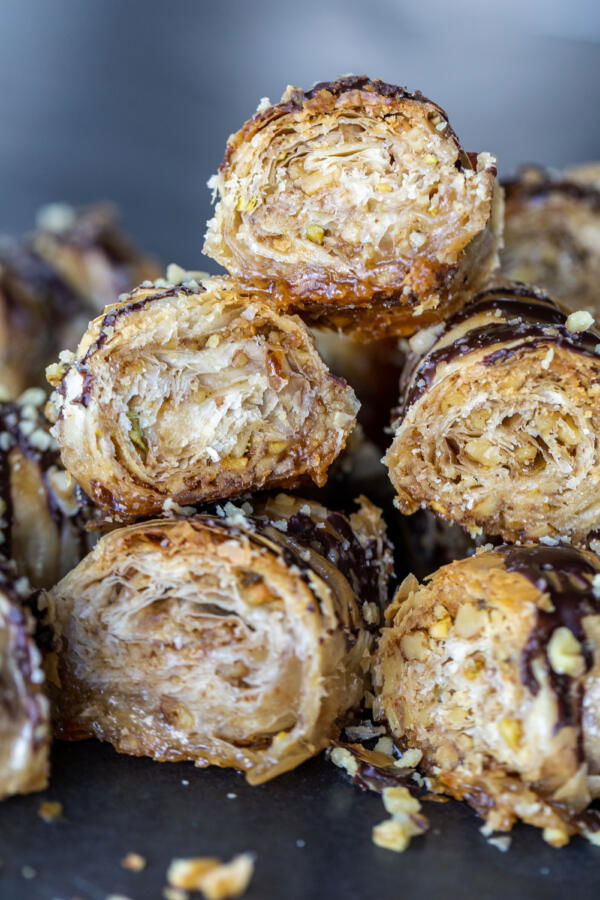
Storing Baklava
My recipe for rolled baklava makes a generous amount, so just in case you have a good portion left over after dessert, you’ll need to store it correctly to enjoy it in the days to come.
- Refrigerator/room temperature: Keep the baklava from getting soggy by covering it lightly with a plastic wrap and placing it into an airtight container in the fridge or at room temperature (up to three days). Store it only after it has fully soaked up the sweet mixture.
- Freezer: Freeze individual pieces of baklava for up to three months. If needed, layer wax or parchment paper between the pieces to prevent sticking. Thaw in the refrigerator overnight.
More Nutty Sweet Treats
- Walnut Cookies aka Oreshki – Sweet, dulce de leche filled cookies
- Honey Walnut Poppy Seed Cake – Moist honey & nut cake
- Jam and Nuts Rugelach – Polish-style rolled cookies
- European Peach Cookies – Peach-shaped dulce de leche cookies
Recipe
Ingredients
- 18 sheets phyllo dough 9×14 in size
- 2 cups walnuts or optional other nuts
- 1 cup powdered sugar
- 1/2 tbsp ground cinnamon
- 1 cup melted butter
- 1 cup sugar
- 1/2 cup water
- 1/4 cup honey
- melted chocolate optional, for garnish
- chopped walnuts optional, for garnish
Instructions
- In a food processor, chop the walnuts into tiny pieces.
- Place the chopped walnuts in a bowl and toss with powdered sugar and cinnamon. In a separate bowl, melt the butter.
- Lay out one phyllo sheet at the time, then brush it with melted butter until you have a total of three stacked buttered sheets.
- Spread 1/3 cup of the nut mixture evenly onto the stack of buttered sheets. Roll the sheet up (from the short edge) into a tight roll and set it in a 9×13 baking dish. Repeat the process until you run out of ingredients (you should have 6 rolls in all).
- Brush the rolled baklava with melted butter. Bake it at 375°F for 25 minutes.
- In a small pot, combine the sugar and water and cook it on low heat for about 10 minutes. Add the honey and stir until it's melted.
- Pour the mixture over the hot rolled baklava and allow the baklava to rest for at least 3 hours. Slice the baklava rolls into your preferred size, and then garnish with melted chocolate and chopped walnuts before serving, if desired! Enjoy!

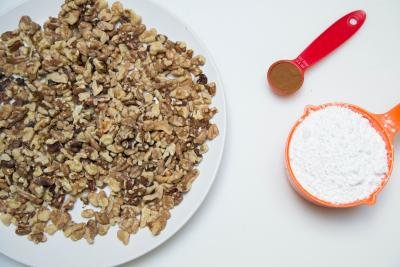
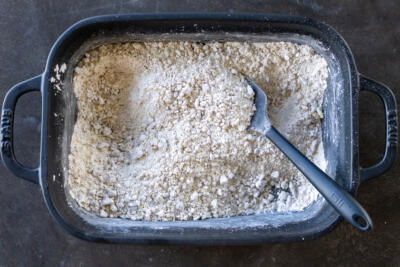
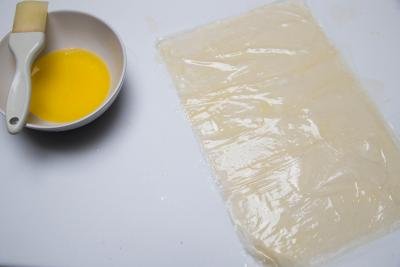

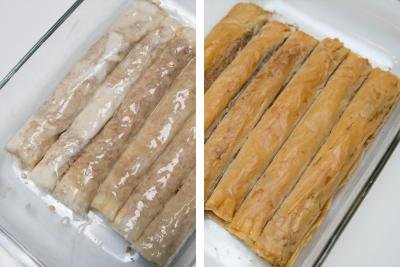
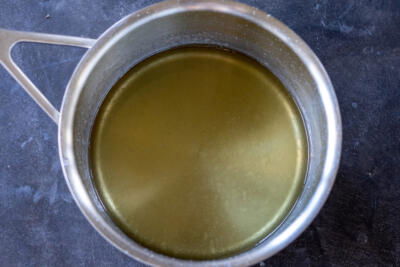
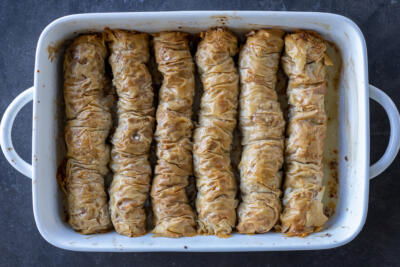
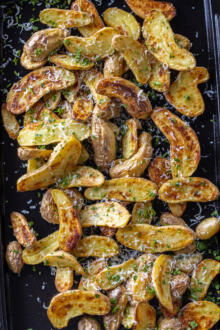


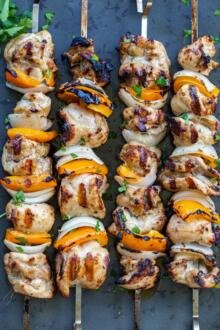


I’ve made this recipe multiple times over a number of years. Everyone loves it every time. It never fails. I always end up using 2 sticks of butter though! Apologies for not reviewing this sooner. Great job and thank you!
You’re the best! I’m so happy it’s been a hit every time. Sometimes I go generous on butter too 😂 Thanks for finally leaving a review—means a lot!
Sounds easy and delish! Can you recommend how many days in advance I can make it?
Yes, it’s super easy and delicious! You can make rolled baklava about 2-3 days in advance. Store it in an airtight container, or loosely covered with a paper towel at room temperature. Avoid using plastic wrap, as it can trap moisture, and keep it in a cool, dry place to maintain its crisp texture. If you want to make it even earlier, you can freeze it before baking and just bake it when you're ready. That way, you get that freshly-baked taste anytime! Enjoy!
Awesome. Do you use roasted or raw nuts? Can you make a creme cheese version??? What recipe would I use for the cheese???
Either or, I used raw in my recipe. I don't make Baklava with cream cheese but it sounds like it could be fun to try!
So easy and the baklava turned out really well!!
Thanks for sharing Sadie! Glad you enjoyed it!
Can I swap out butter for margaine for a vegan treat? Someone said they tend to burn?
I used nuttlex and it worked great! Only took 20mins in my oven. Hope this helps!
Hey, I personally have not experimented with margarine. I would highly recommend using butter for that buttery, flakey, flavor baklava is known for.
Thank you for this easy-to-follow recipe. It was my first time making baklava, and I was successful thanks to you!
Hi Suzanne, My pleasure! I'm glad it worked out perfectly!
Raspberry Almond Baklava Rolls
unique twist on traditional baklava, combining the flavors of raspberries and almonds in a delightful pastry
Hi Naveed, That flavor combination sounds delicious! Thanks for sharing 🙂
I recently had the opportunity to try out the Rolled Baklava and I must say it was a delightful experience."
Hi Naveed, Baklava is very delightful indeed!
I made this recipe! We usually make baklava in a LARGE pan. This was nice for a quick small pan. Thanks!
Anna, thats great to hear. I love the quick smaller portion or we have too much temptation laying around. 🙂 Enjoy
Hello, for gluten free in your recipe the only think has to be gluten free is the phyllo dough right?
HI John, yes, if you swap out for gluten free phyllo dough, the recipe will be gluten free. This recipe is a hit every time we make it. Please report back, I want to hear what you think of it.
Is there a substitute for nuts? My grandson is allergic. It sounds wonderful. Can’t wait to try this easier recipe. Thank you for sharing.
Hi Martha, You can use chocolate chips, or simply not use the nuts and leave everything else as it is. I hope this helps. Wishing you the best of luck!
Been making Baklava for 35 years. I put a little orange extract in my basting sauce. Its a nice change. Lemon is very good too!
Hi Debra, thank you for sharing your process with me! I would love to give the orange extract a try sometime!
I did fresh lemon juice that was really good too!
That sounds delicious! Thank you for sharing Candace.
I’m getting ready to make your baklava tomorrow. Just wondering how big are the sheets of phyllo you used for this recipe? Mine are 14 x 18 I just want the nuts/phyllo ratio to be close 🙂 thanks!
One other question… could you use smaller sheets like 9x14… I often have this in the freezer and this would be a great way to use it up and make a sweet treat. Maybe just use more sheets to compensate for smaller size? Thanks again.
Hi Shari, the one that I use are the typical 9X14 size sheets. Hope you love the recipe. I would love to hear feedback. 🙂
I made the baklava … twice! It turned out delicious, I was so excited!! This will be my go to recipe … why torture myself making the one with layers! Thank you 🙂
Hi Shari, That makes me so happy to hear! I am thrilled that you found a recipe that you absolutely love! It's my mission to simplify cooking as much as possible! Thank you for your feedback. Enjoy!
have not made them yet but wondering if you are rolling them from the short edge or long edge? Thanks joyce
Hey Joyce, I roll from the short edge. See the picture in step 3 for reference. Enjoy!
I really love this recipe and am thinking about making it as a take away gift for an upcoming wedding. I'm a bit worried about the amount of syrup sitting at the bottom of the pan after the baklava has rested in it for 3 hours and even overnight. Seems like a bit much. Should all of it be absorbed?
How far in advance could I make it and keep it crisp? I cannot travel with it made already so it would have to be a few days before our event. What would be the best way to store it if I made it 2 nights before? I plan to put them in small sealed boxes. Wondering if that could be done 2 or 3 days ahead and stored in refrigerator? Thanks for an excellent recipe. I keep making it and trying different add ins to the syrup as others have suggested. Always good!
Hey JJ- these are great questions. You should be able to store it in the fridge no problem, make sure it's in an airtight container so it stays as fresh as possible. I've even read that you can store it at room temp in an airtight container, but haven't personally tested this. Since this is for a wedding favor, I recommend you make some in advance as a "test" and see which method you prefer so that you are satisfied with the results for the big day! Thank you for the kind feedback!
I've tried a few different recipes over the years and yours looks delicious! I'll be trying it this weekend. I love doing rolls instead of the large sheets cut into diamonds - makes it a lot easier! I make my syrup out of water, sugar, honey, rose water and lemon juice! Everyone wonders what the delicious "floral" taste is! lol
Hi Erica - That sounds BOMB! I bet rose water adds such a beautiful depth of flavor. Let us know how it turns out and happy baking! 🙂
Do you suggest precutting these a bit like regular sheet baklava in order to help with cutting through the film after baking? Also, what do you think about slicing the pieces before adding the syrup on top?
Hi Emily - Thanks for the note! Part of what makes these the "easiest" is that you don't have to fuss around with cutting the sheets or cutting the baklava into smaller pieces. That said, you can definitely cut them down if you'd like. Hope this helps!
I added spices we tasted while in Greece a few months ago. I wanted to try the rolled baklava. The crunch is delicious. Added lemon and cinnamon stick to the sugar water. Very good. Bit too much work for 8 dozen. But great for smaller batches.
Hi Debbie - That sounds BOMB! We will have to try this in our test kitchen. I bet the lemon juice adds such a nice, puckery flavor. Thanks for sharing!
I’m definitely going to try your baklava! I was at the store and noticed the phyllo sheets came in different sizes. What size are the sheets you used?
Hi Shari - Thanks for reaching out! I use different sizes each time, but try and go for the larger sheets since they are easier to roll and handle. Hope this helps and I'm so excited for you try it!
So simple and so much easier than making sheets. The most difficult part is getting to the store to buy the phyllo sheets! :O)). Thank You!
Hi there! Love to hear it. We feel the same way about this method being so much easier than making sheets. If only we could clone ourselves and send one of us to the store (HAHA!). Thanks for the love and so nice to hear from you!
Hi. Is filo sheet same as spring roll sheets?
Hey Mon, I dont think they are the same thing but I am not 100% sure. Maybe try to google for the difference. I never worked with spring roll sheets.
I do make Baklava, using a recipe from my Albanian born Mother. I use a ‘heavy’ syrup (sugar and water), and no honey. I assume this would work, what do you think? I am going to try your roll up method soon 😊
Hey Connie, yes, it sounds like it should work. Enjoy it
Dry on the inside. Next time I would drizzle some of the topping inside the rolls before rolling.
Thank you for the tip, sorry they didn't work out well for you.
A solid recipe and easily executed! These are actually called warbat in Arabic as I was informed by my friend and can be filled with custard, nuts or sweet cheese and eaten for breakfast.
I added orange zest from one orange, two slices of orange, cinnamon, cardamon and star anise (a dash of each and one star anise seed pod) to the syrup for a deeper flavor profile. I also baked it about 35mins to get a more golden color on top. It's good to pour the syrup on when the syrup is room temperature and the baklava fresh out of the oven.
Last note, I had about one cup of pistachios left from another recipe so I just tossed them in with the walnuts and blitzed them together. Delish!
Great recipe, very tasty!
Thank you for sharing all of that information and those tips! Interesting idea on adding the orange, sounds like it adds tons of flavor! Thank you for taking the time to comment.
Perfection! Just the right amount of sweetness. When I pull the baklava from the oven, I let it cool for an hour or two and then place the baklava itself on cooling wracks with parchment paper underneath so it doesn’t sit in the syrup and become soggy. Thanks for sharing!!
Hi Karen, thank you for all of the tips! I hope you love the baklava.
I had to double the filling to do the 6 rolls, but that’s ok
Hey Sandra, you can add more filling if that is your preference.
Submitted for your approval ... use 1 sheet of phyllo. Butter 2/3s of it (vertically). Fold the unbuttered third over the middle third, then the last third over that middle. Voila 3 layers. Much easier than trying to line up the three sheets. Then just a couple Tablespoons of the walnut filling - and then only 1 or 2 cuts on the finished roll (if any cuts at all).
(learned this 1-sheet-into-thirds trick with making spanakopita... makes an appetizer size perfect for parties)
Are you able to show a picture of this? Are they in triangles? Thank you!
Hi Emily - The sheets are not in triangles. They come in squares ad we just roll them up. Hope this helps!
Izzy, great tips. Thank you for sharing!
I made this yesterday and it's the best baklava I've ever made. I won't be using any other recipe again. I added the juice of a lemon to the syrup to give it a bit of a tang. Fantastic tasting and so quick and easy to make. Thank you xx
Hey Fiona, I am so glad to head this feedback. I love the idea of lemon juice, trying it next time for sure!
Hi Greek immigrant here... we ALWAYS add the juice of a lemon to the honey liquid. It not only flavors but keeps the sugar from crystallizing. Happy baklava!!!
Angela, this is such a great tip. Thank you!
My daughter and I made this today. I made it 2 1/2 hours before tasting it. It's insanely amazing. Once we got the hang of separating the sheets and then rolling, it went very well and was pretty easy. We will most definitely be making this again.
Hey Jean, I am so glad you love this recipe. I think the hardest part is the waiting time. Thank you for sharing your feedback! 🙂
This recipe is life changing. I love baklava but it's so time consuming I don't make it very often. Yay for a great shortcut.
Krissy, yes this one made our life so much easier 🙂 Glad you like the recipe!